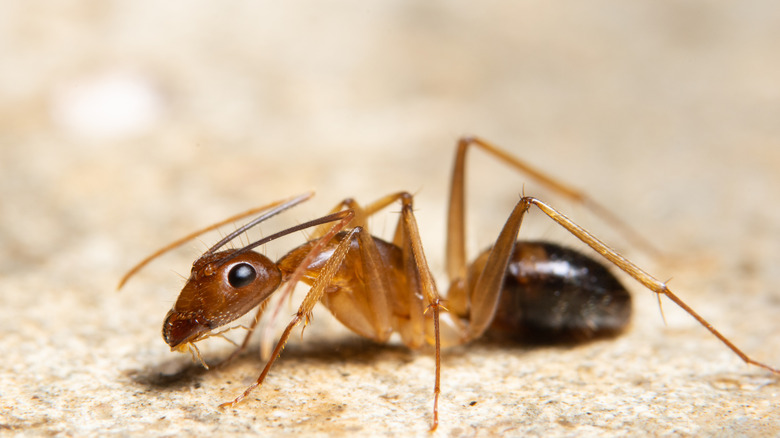What To Do If You Spot Ghost Ants In Your Home
Encountering ants in your home can be a frustrating experience. One of the most common household pests, there are over 12,000 species in the world. Surprisingly, out of that number, only a handful of ants wander inside your home. Within North America, for instance, around 25 ant species have been classified as frequent indoor pests. One such species that has been causing havoc in tropical regions such as Florida and Hawaii is the ghost ant. Named for its tiny size and translucent body parts, you're likely to find ghost ants taking up residence in your kitchens and bathrooms. Because of their size and coloring, it can be easy to miss signs of infestation, according to Orkin Pest Control. If you keep spotting trails of ants in your home, there are a few strategies you can take to manage their presence so your pest infestation doesn't become a bigger problem.
Compared to pests such as carpenter ants, ghost ants do not cause any immediate harm to your household. And unlike fire ants and other species, these ants do not have a stinger. Still, they can spread bacteria through their foraging activities. If you notice an increase in ants, it's important to get a handle on the situation, otherwise your unwanted visitors could grow to unmanageable numbers. Ghost ants are attracted to moisture and humidity, which explains why you might find ant trails near sinks and shower stalls. These ants also have a sweet tooth, and will devour any food left unattended. If you want to get rid of the ants, you can set homemade or commercial gel baits that will aid in reducing infestations. Beyond that, there are a few preventative measures you can take, including sealing food away in containers, fixing any moisture leaks, and keeping your home pristine.
What are ghost ants?
It is believed that ghosts ants originated in a region located in either Africa or Asia. They are known as tramp ants, a term given to species who transport from area to area via human activity along commerce routes. Their first documented appearance in North America was in Florida, and by 1995 the ant had became a common pest in the state, especially in the central and southern regions. While they prefer tropical climates, they have been found in heated buildings and greenhouses further north. Hairless, spineless, and measuring less than a 16th of an inch long, these minuscule critters are identified by their dark head and thorax alongside abdomen and legs that are milky white to the point of being see-through. Another surefire way to identify ghost ants: if you crush them, the worker ant will release a rotten coconut smell.
Highly adaptable and active year round, they are equally at ease indoors and outdoors. They often enter the house using overgrown vegetation or utility wires that bump against your home. There can be multiple queens in a colony, which is why their populations can rise so rapidly. Often, one queen will take some workers elsewhere to build another nest, creating satellite colonies for the workers to trail back and forth between. Once indoors, ants will establish nests in crevices or cracks located in wall voids, between baseboards and cabinets, and even book bindings. If you have any potted plants, ghost ants can make a home in the soil, too. They especially like plants that attract aphids and other honeydew-producing insects, since they are big fans of the sugary substance. Cakes, cookies, candies, and other syrupy confections are other favorites.
Tips for management and prevention of ghost ants
Once you've notice ghost ants in your home, the next step is to assess the magnitude of the problem. Start by inspecting your windows, doors, food storage areas, and bathroom sinks for any trail activity. If you are able to follow the trails, you might be able to locate nests or entry points. From there, try setting DIY or store-bought gel baits around trail areas. You can make your own bait by combining one part borax with three parts of either powdered sugar or peanut butter and replacing the bait every few days. Eventually, worker ants will bring the bait back home to the colony, where the borax will slowly kill off rest of the group. However, be aware that these traps are only effective if ghost ants ingest the mixture and bring it back to their nest. This method requires extreme patience, since non-repellant baits kill ants over an extended period of time. And while setting up your own baits is advised for homes with a minor ghost ant problem, if you're dealing with a major infestation, it's best to call in pest control.
If you want to prevent ghost ants, cleanliness is key. Make sure to seal away food in airtight containers. Check your sinks, toilet, and tubs for any leaks, since foraging ghost ants are always on the hunt for moisture. Caulk any potential entry points near doors and windows. If you have any trees or shrubs that touch the house, trim them back to deter ants from coming indoors. Other outside sources that can lure ants into your home include leaf litter, firewood, and any mulch placed near your home. Keep any wood piles at least 20 feet from your house, and consider setting up a dry barrier between mulch and your foundation.


